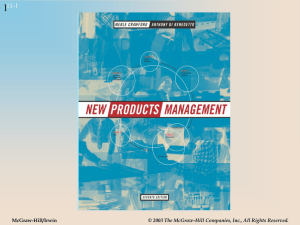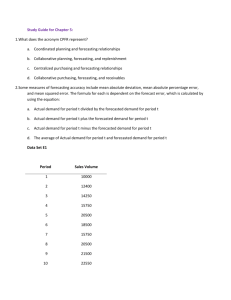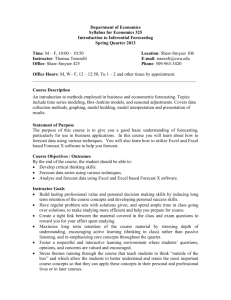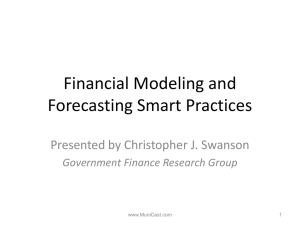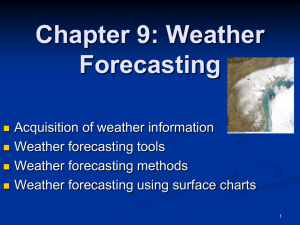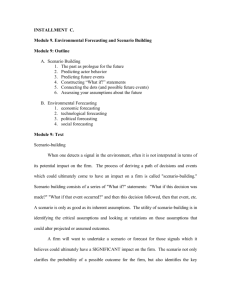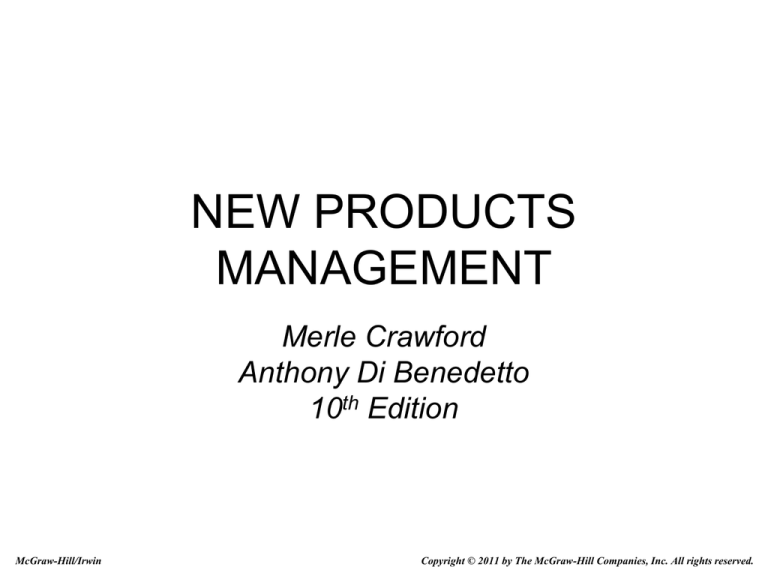
NEW PRODUCTS
MANAGEMENT
Merle Crawford
Anthony Di Benedetto
10th Edition
McGraw-Hill/Irwin
Copyright © 2011 by The McGraw-Hill Companies, Inc. All rights reserved.
Chapter 11
Sales Forecasting and Financial Analysis
11-2
Why Financial Analysis for New
Products is Difficult
• Target users don’t
know.
• If they know they
might not tell us.
• Poor execution of
market research.
• Market dynamics.
• Uncertainties about
marketing support.
• Biased internal
attitudes.
• Poor accounting.
• Rushing products to
market.
• Basing forecasts on
history.
• Technology
revolutions.
11-3
Forecasting the Demand For
Satellite Radio
• In 2000: forecast for 2007 was 36 million
subscribers.
• In 2001: forecast revised to 16 million.
• By end of 2006: actual number of
subscribers = 11 million.
Source: Sarah McBride, “Until Recently Full Of Promise, Satellite Radio Runs Into Static,”
Wall Street Journal, August 15, 2006, pp. A1-A9.
11-4
Forecasters Are Often Right
In 1967 they said we would have:
• Artificial organs in humans by 1982.
• Human organ transplants by 1987.
• Credit cards almost eliminating currency by 1986.
• Automation throughout industry including some
managerial decision making by 1987.
• Landing on moon by 1970.
• Three of four Americans living in cities or towns by
1986.
• Expenditures for recreation and entertainment
doubled by 1986.
11-5
Forecasters Can Be Very
Wrong
They also said we would have:
• Permanent base on moon by 1987.
• Manned planetary landings by 1980.
• Most urbanites living in high-rises by 1986.
• Private cars barred from city cores by 1986.
• Primitive life forms created in laboratory by 1989.
• Full color 3D TV globally available.
Source: a 1967 forecast by The Futurist journal.
Note: about two-thirds of the forecasts were correct!
11-6
Commonly Used Forecasting
Techniques
Technique
Simple Regression
Multiple Regression
Time Horizon
Short
Short-medium
Cost
Low
Moderate
Econometric
Analysis
Simple time series
Advanced time
series (e.g.,
smoothing)
Jury of executive
opinion
Scenario writing
Delphi probe
Short-medium
Moderate to high
Short
Short-medium
Medium
Very low
Low to high,
depending on
method
Low
Medium-long
Long
Moderately high
Moderately high
Comments
Easy to learn
More difficult to
learn and interpret
Complex
Easy to learn
Can be difficult to
learn but results are
easy to interpret
Interpret with
caution
Can be complex
Difficult to learn
and interpret
11-7
Forecasting Satellite Radio Sales
Using Purchase Intentions
•
•
•
•
•
•
•
•
•
In 2000, 213 million vehicles in U.S.
95% availability, 40% awareness.
Market potential = 213 million x 95% x 40% = 81 million.
Assume half can afford satellite radio = 40.5 million.
Percentage that will be among the first to try the new
technology = 16%.
Forecast for first year = 40.5 million x 16% = 6.4 million.
Projected yearly growth rate = 10%.
Assuming this growth rate, by end of 2006, expected
total sales = about 10 million.
Note: not too far from the attained number = 11 million!
11-8
Handling Problems in Financial
Analysis
• Improve your existing new products process.
• Use the life cycle concept of financial analysis.
• Reduce dependence on poor forecasts.
– Forecast what you know.
– Approve situations, not numbers (recall
Campbell Soup example)
– Commit to low-cost development and marketing.
– Be prepared to handle the risks.
– Don’t use one standard format for financial
analysis.
– Improve current financial forecasting methods.
11-9
Forecasting Sales Using Purchase
Intentions
• Use top-two-boxes scores obtained in concept testing,
appropriately adjusted or calibrated.
• Example: Recall for hand cleanser from Chapter 9:
– Definitely buy = 5%
– Probably buy = 36%
• Based on history, calibrate as follows:
– 80% of “definitelies” actually buy
– 33% of “probablies” actually buy
• Forecasted market share = (0.8)(5%) + (0.33)(36%) =
16%.
11-10
Forecasting Sales Using Purchase
Intentions (continued)
• The 16% forecast assumes 100% awareness
and availability.
• Adjust downwards to account for incomplete
awareness and availability.
• If 60% of the market is aware of the product and
has it available, market share is recalculated to
(0.6) (16%) = 9.6%.
11-11
Forecasting Sales Using A-T-A-R
Model
• Assume awareness = 90% and availability = 67%.
• Trial rate = 16% (16% of the market that is aware of the
product and has it available tries it at least once).
• RS = proportion who switch to new product = 70%.
• Rr = proportion who repeat purchase the new product =
60%.
• Rt = Long-run repeat purchase = RS /(1+Rs-Rr) = 63.6%.
• Market Share = T x Rt x Awareness x Availability =
16% x 63.6% x 90% x 67% = 6.14%.
The following bar chart shows this procedure graphically.
11-12
A-T-A-R Model Results:
Bar Chart Format
100%
90%
80%
70%
60%
50%
40%
30%
20%
10%
0%
0.9
0.603
Aware
Available
0.0965
0.0614
Trial
Repeat
11-13
Bass Model Forecast of
Product Diffusion
11-14
The Life Cycle of Assessment
11-15
Calculating New Product’s
Required Rate of Return
% Return
Reqd. Rate
of Return
Cost of
Capital
Avg. Risk
of Firm
Risk on
Proposed
Product
Risk
11-16
Real-Options Analysis in New
Product Value Assessment
Data:
• Startup costs in Year 0: $70,000.
• The cash flows for Years 1 through 4 are estimated to be
$40,000 in a high-demand scenario, or $10,000 in a lowdemand scenario.
• The probabilities of a high- or low-demand scenario are
both 50 percent.
• The product concept could be abandoned after Year 1,
and the equipment could be sold for $38,000.
• Discount rate = 12%.
11-17
Real-Options Analysis
(continued)
Cash flow in Year 1 for each demand scenario:
Demand
Year 1
Year 2
Year 3
Year 4
Total
High
40,000
10,000
40,000/(1.12)2 =
31,888
10,000/(1.12)2 =
7,972
40,000/(1.12)3 =
28,471
10,000/(1.12)3 =
7,118
$136,073
Low
40,000/(1.12)
= 35,714
10,000/(1.12)
= 8,929
$34,018
Cash flow in Year 1 if option taken to abandon
project and equipment is sold:
Demand
Year 1
Low
10,000
Take Option to
Abandon and Sell
Equipment
38,000
Total
$48,000
Therefore the project would be abandoned after Year 1.
11-18
Real-Options Analysis (continued)
Now assess NPV for each demand scenario, assuming project is
abandoned after Year 1 if demand is low.
Demand
Year 0
Year 1
Year 2
Year 3
Year 4
Total
High
-70,000
40,000/(1.12)2 =
31,888
40,000/(1.12)3 =
28,471
40,000/(1.12)4 =
25,421
$51,494
Low
-70,000
40,000/(1.12)
= 35,714
48,000/(1.12)
= 42,857
-$27,143
Expected value of investment is:
(0.5)($51,494) + (0.5)(-27,143) = $12,176
Since this expected value is greater than zero, the firm should make the
investment.
Source: Edward Nelling, "Options and the Analysis of Technology Projects," in V. K. Narayanan
and Gina C. O'Connor (eds.), Encyclopedia of Technology & Innovation Management, Chichester,
UK: John Wiley, 2010, Chapter 8.
11-19
Hurdle Rates on Returns and Other
Measures
Product
A
B
C
Strategic Role or Purpose
Sales
Combat competitive entry
Establish foothold in new
market
Capitalize on existing
markets
$3,000,000
$2,000,000
Hurdle Rate
Return on
Investment
10%
17%
$1,000,000
12%
Market Share
Increase
0 Points
15 Points
1 Point
Explanation: the hurdles should reflect a product’s purpose,
or assignment. Example: we might accept a very low
share increase for an item that simply capitalized on our
existing market position.
11-20
Hoechst-U.S. Scoring Model
Key Factors
Probability of Technical
Success
Probability of Commercial
Success
Reward
Business-Strategy Fit
Strategic Leverage
1
……….
<20% probability
<25% probability
Small
R&D independent of
business strategy
"One-of-a-kind"/
dead end
4
Rating Scale (from 1 - 10)
……….
7
……….
10
>90% probability
>90% probability
Payback < 3 years
R&D strongly supports
business strategy
Many proprietary
opportunities
Source: Adapted from Robert G. Cooper, Scott J. Edgett, and Elko J. Kleinschmidt. Portfolio Management
for New Products, McMaster University, Hamilton, Ontario, Canada, 1997, pp. 24-28.
11-21
Specialty Minerals Scoring Model
•
•
•
•
•
•
•
Management interest
Customer interest
Sustainability of competitive advantage
Technical feasibility
Business case strength
Fit with core competencies
Profitability and impact
11-22
Manufacturing Firm Scoring Model
(disguised)
• Net Present Value
• Internal Rate of Return
• Strategic Importance of Project (how well it
aligns with business strategy)
• Probability of Technical Success
Note how in each of these examples, the model contains
financial as well as strategic criteria.
11-23
A Tool for Concept Evaluation
Strategic Fit
Does the concept fit with corporate vision?
Customer Fit
Does the concept allow the customer to better meet consumer needs?
Consumer Fit
Does the concept satisfy an unmet consumer need?
Market Attractiveness
Is the concept unique relative to competition?
Technical Feasibility
Is the concept feasible and protectable?
Financial Returns
Will the project break even soon?
Source: Erika B. Seamon, “Achieving Growth Through an Innovative Culture,” in P. Belliveau, A.
Griffin, and S. M. Somermeyer, The PDMA Handbook 3 For New Product Development, Wiley,
2004, Ch. 1.
11-24

